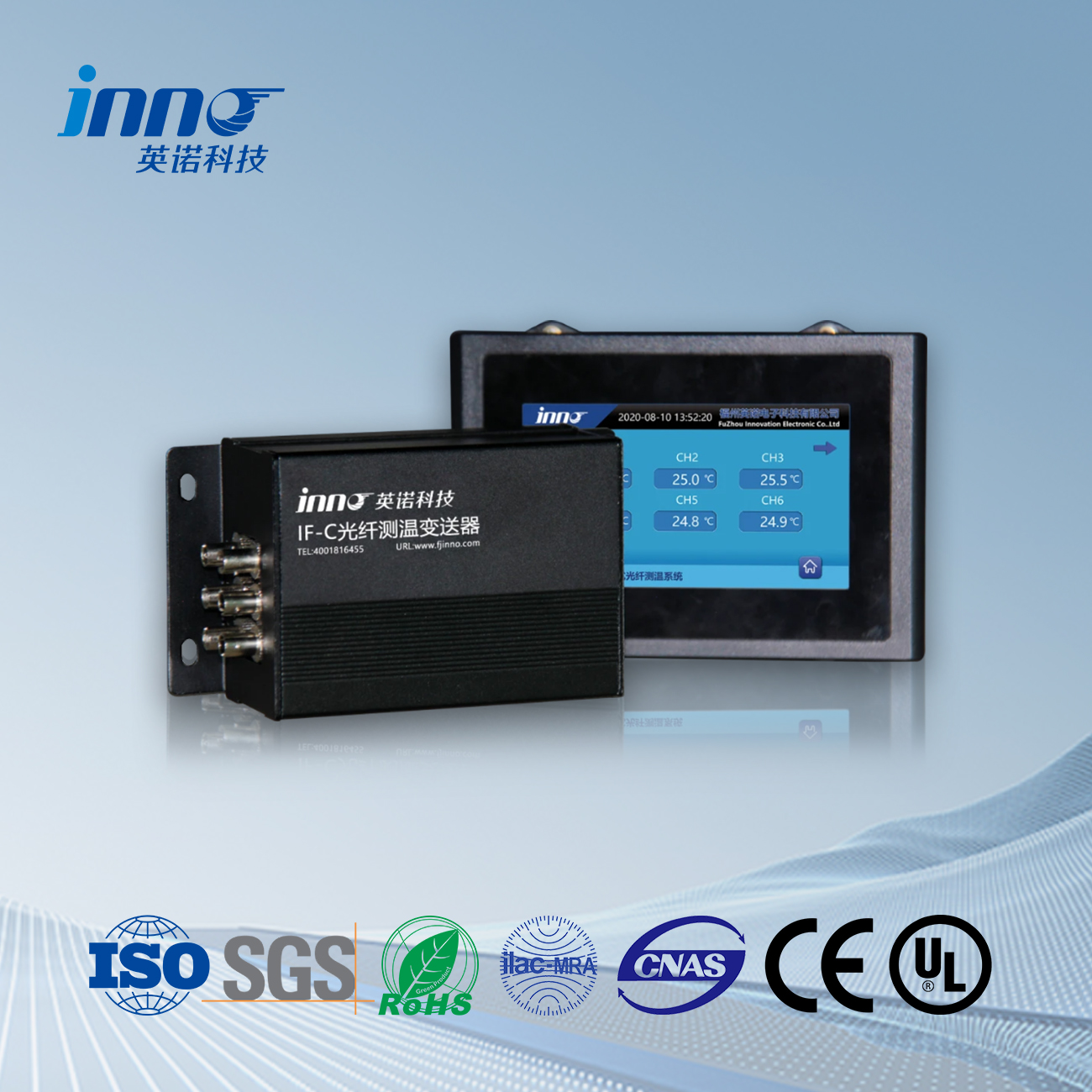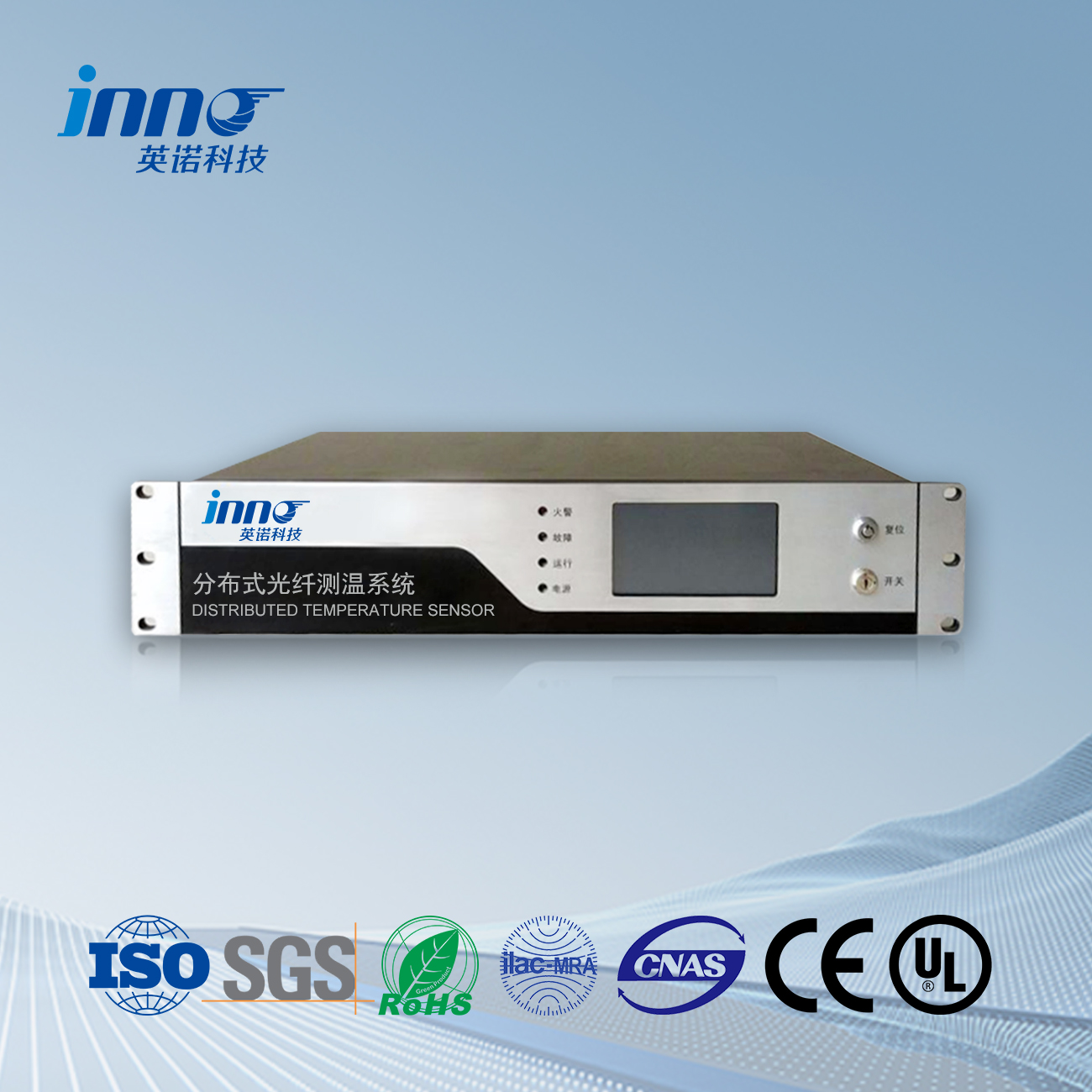Principles of temperature measurement
Fluorescence afterglow time method: This is one of the most commonly used principles. The front end of the fluorescent fiber optic sensor is coated with a fluorescent substance, which produces fluorescence when excited with a light pulse of a specific wavelength. The decay time of the fluorescence has a clear correspondence with the temperature, the higher the temperature, the shorter the fluorescence afterglow time. By accurately measuring the change in fluorescence afterglow time, the temperature of the object to be measured can be calculated.
Fluorescence Intensity Method: The change of luminous intensity of fluorescent substances at different temperatures is utilized to measure temperature. Quando la temperatura cambia, the luminous intensity of the fluorescent substance will also change accordingly, and the temperature can be determined by measuring the change in luminous intensity. Tuttavia, this method is susceptible to fluctuations in the light source and fiber optic transmission loss, there are certain limitations on the measurement accuracy.
Fluorescence spectrometry: Based on the principle that the characteristics of the emission spectrum of fluorescent substances change with temperature. The peak wavelength or spectral shape of the emission spectrum of the fluorescent substance changes at different temperatures, and the temperature measurement is realized by analyzing the changes in the fluorescence spectrum, but this method usually requires more complex spectral analysis equipment.
System Components
Light source: Pulsed lasers or high-intensity light-emitting diodes (LEDs) are usually used as the light source to generate excitation light pulses to stimulate the fluorescent substance to emit light. The light source is required to have a suitable wavelength, sufficient optical power and good stability to ensure the quality of the fluorescence signal and the accuracy of the measurement.
Fluorescent fiber optic sensor probe: It consists of optical fiber and fluorescent substance, the optical fiber is used to transmit excitation light and fluorescent signal, and the fluorescent substance is the key component to feel the temperature change. Fluorescent substances generally have good temperature sensitivity and stability, such as rare earth doped fluorescent materials.
Photodetector: Used to convert fluorescent signals into electrical signals. Common photodetectors are photodiodes, photomultiplier tubes, and so on., which are required to have high sensitivity, fast response and low noise characteristics in order to accurately detect weak fluorescent signals.
Signal processing unit: process and analyze the electrical signal output from the photodetector, extract the characteristic parameters related to temperature, such as fluorescence afterglow time, fluorescence intensity, and so on., and convert them to temperature value output. Usually includes amplifier, analog-to-digital converter, digital signal processor and other circuits.
Temperature measurement steps
1. Installation of the probe: according to the specific conditions of the object to be measured, the fluorescent fiber optic sensor probe is placed in the appropriate temperature measurement position, to ensure good contact between the probe and the object to be measured or in the microwave field of the object to be measured.
2. Excite the light source: turn on the light source, generate light pulses with certain energy and suitable wavelength, and transmit the light pulses to the fluorescent fiber optic sensor probe through the optical fiber.
3. Generate fluorescent signal: the fluorescent material on the probe is excited by the light pulse, generates fluorescence, and transmits the fluorescent signal back to the photodetector through the optical fiber.
4. Signal detection and processing: the photoelectric detector converts the received fluorescent signal into electrical signal, the signal processing unit amplifies, filters, analog-to-digital conversion and other processing of the electrical signal, extracts the characteristic parameters of the fluorescent signal, and calculates the temperature of the object to be measured according to the pre-calibrated fluorescent signal-temperature relationship.
Advantage
Interferenza anti-elettromagnetica: fluorescent fiber optic sensors are made of non-metallic materials, there is no problem of electromagnetic induction, not affected by strong electromagnetic interference in the microwave field, and can accurately measure the temperature, while traditional metal temperature sensors will produce induced currents in the microwave field, which will lead to measurement errors or even impossible to measure.
Safe and reliable: intrinsically safe, no potential danger of electric sparks, can be used for temperature measurement in flammable and explosive and other hazardous environments.
Corrosion resistance: fiber optic material has good chemical resistance, can work stably in corrosive environments for a long time.
High precision and high resolution: able to achieve high temperature measurement accuracy and resolution, can accurately measure small temperature changes.
Small size: the sensor probe is small in size, which can realize the temperature measurement of small-sized objects or narrow space, and has little influence on the thermal characteristics of the measured object.
Multi-point measurement: By connecting multiple fluorescent sensor probes to the same fiber optic temperature measurement device, it is easy to realize multi-point temperature measurement and real-time monitoring of temperature changes at different locations of the object to be measured.
Application Cases
Medical field: In tumor thermotherapy instrument, fluorescent fiber optic sensor can accurately measure the temperature of the tumor site to help doctors control the treatment temperature, improve the therapeutic effect, and avoid damage to normal tissues; in nuclear magnetic resonance (NMR) equipment, it is used to monitor the temperature of the key components of the equipment to ensure the normal operation of the equipment.
Industrial microwave equipment: In the microwave heating equipment in food processing, microwave digestion/extractor and other industrial microwave equipment, fluorescent fiber optic sensors can be used to monitor the temperature of the heated object in the microwave cavity or the key components of the equipment itself, to ensure the quality of the product and the safe operation of the equipment.
Sensore di temperatura in fibra ottica, Sistema di monitoraggio intelligente, Produttore distribuito di fibre ottiche in Cina
 |
 |
 |
 Sensori di temperatura a fibra ottica INNO ,sistemi di monitoraggio della temperatura.
Sensori di temperatura a fibra ottica INNO ,sistemi di monitoraggio della temperatura.

